An ear plug is a small device, typically made of foam or plastic, that is inserted into the ear to protect the user from excessive noise.
Ear plugs take many forms, with some being disposable and some reusable. They also exhibit different levels of noise protection, with most adhering to the widely adopted Noise Reduction Rating (NRR) system. This system allows you to determine which ear plugs would be right for your particular circumstances.
Our product and health experts have determined that the following are the best ear plugs of 2023.
Rankings
1. Decibullz Custom Molded Earplugs
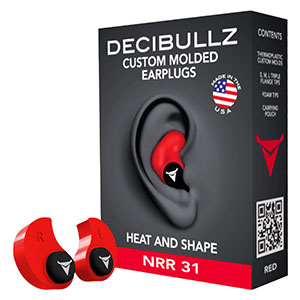
Click here for the lowest price on Amazon
Decibullz ear plugs are ideal for sleeping, but they perform equally well at work or on the firing range. All you do is heat them up, place them, and squish them around until they mold themselves to the exact shape of your ear.
What we like: They’re like having high-end cans over your ears. The 31 NRR rating is just shy of the highest available. And they live up to it. It’s also nice that if the first fitting doesn’t go as you hoped, you can just warm them up and do it again.
Flaws: They cost a lot more than any standard ear plug.
2. Moldex Soft Foam Ear Plugs
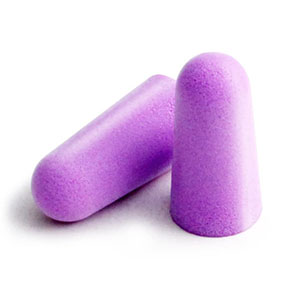
Click here for the lowest price on Amazon
These Moldex ear plugs hit the sweet spot. They feature the highest NRR rating, are very affordable, and can be used for work, sleep, travel, club-hopping, jamming, and much more. For pennies apiece, you can’t go wrong.
What we like: We appreciate they provide the highest NRR rating available (33) and yet they’re so affordable. We also like the convenient carrying case. The money-back guarantee is just icing on the cake.
Flaws: They’ll sometimes pop out on people with tight ear canals. If you’re working outdoors, that can be a problem.
3. 3M 90716 Corded Reusable Earplug
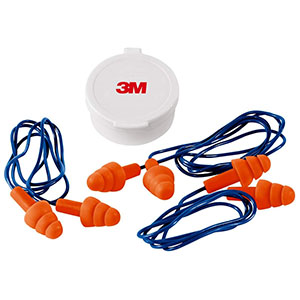
Click here for the lowest price on Amazon
Sometimes you need to block the sound from that stack of Marshall amps. And sometimes you just need to take the edge off of the noise in the cafe so you can study. 3M’s 90716 Corded Reusable plugs are perfect for less extreme applications.
What we like: We like how comfortable these are even over long periods. They’re also easy to remove regardless of how long you’ve had them in. And they effectively cancel out anything above 85 decibels without fail.
Flaws: You sometimes have to give them a pretty good push to seat them properly. If you use them for sleeping, the cord can be a pain.
4. Mack’s Slim Fit Soft Foam Ear Plugs
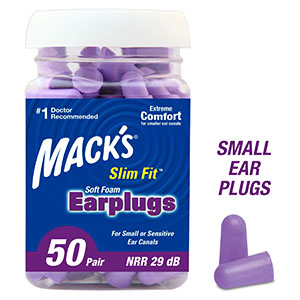
Click here for the lowest price on Amazon
Affordability and effectiveness are the hallmarks of these ear plugs. They’re simple, comfortable, easy on the wallet, and they’ll stay in place all day. If you’re on a budget you don’t have to compromise thanks to Mack’s Slim Fit ear plugs.
What we like: We like how compact and effective they are. The 29 NRR is also surprisingly high for such a simple ear plug. And with a per-unit cost of only pennies, these puppies aren’t going to break anyone’s bank.
Flaws: For people with more cavernous ears, these may, in fact, be too compact. Also, “the #1 recommended doctor’s brand” is open to debate.
5. Howard Leight by Honeywell
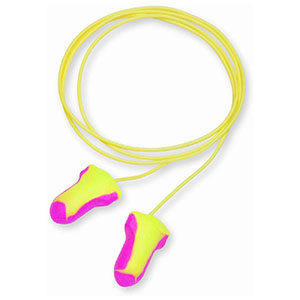
Click here for the lowest price on Amazon
These Howard Leight ear plugs from Honeywell have a slightly different air about them. But they don’t compromise effectiveness for a distinctive look. They’re also some of the most comfortable ear plugs on the market.
What we like: They slip in your ear so comfortably it’s easy to forget you’re wearing them. They do a good job blocking out the worst industrial noise. And they also make good sleeping ear plugs due to their outstanding comfort.
Flaws: Disposable isn’t such a good thing. And they have a tendency to shift in place, especially if you’re very active.
6. Etymotic Research ER20 High-Fidelity Earplugs
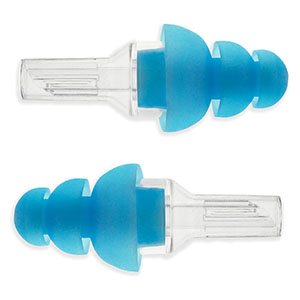
Click here for the lowest price on Amazon
Not everyone’s workplace is like living inside a jet engine. Sometimes you just need to take the top off the sound. For those occasions where the need for noise reduction is not profound, these ER20 Earplugs will fit the bill nicely.
What we like: They’re marketed to musicians, but they’ll work for anyone. We appreciate the way they preserve the integrity of things like speech. Rather than just muffling it. And they tend to stay put once you place them.
Flaws: Noise reduction is not as robust as some other ear plugs. So, if the environment is really loud, you may need something more.
7. Luiswell Silicone Ear Plugs
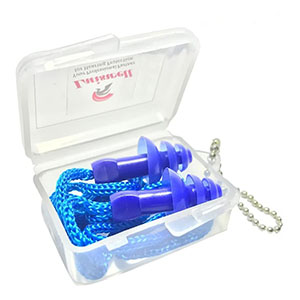
Click here for the lowest price on Amazon
If you work a job that requires you to keep moving, you need ear plugs that are going to stay put. These Silicone Ear Plugs from Luiswell will do just that. They’re great for construction workers, heavy equipment operators, roadies, and more.
What we like: They’re remarkably effective for such affordable ear plugs. We like that they are reusable. And we like how the multi-tier design keeps these ear plugs in place with little effort.
Flaws: The cord can be a little irritating. Especially on hot days. And they’re not all that easy to clean.
8. Organized Explorers Sound Blocker Ear Plugs
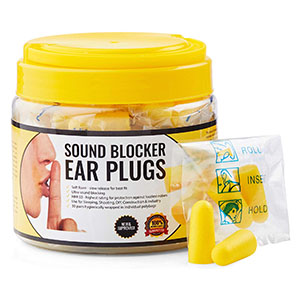
Click here for the lowest price on Amazon
To those who think high-end ear protection has to be expensive, we present the Organized Explorers Sound Blocker Ear Plugs. These are simple, comfortable, work like a charm, stay in place, and cost less than a dollar a pair.
What we like: These ear plugs are very easy to use. You achieve a nice firm plant every time. They’re very comfortable, and the NRR 33 can’t be beat. We also appreciate that they wrap each pair individually to prevent contamination.
Flaws: People with larger ears may find them a bit small. Also, lots of disposable plastic.
9. Honeywell QB2HYG Hearing Bands
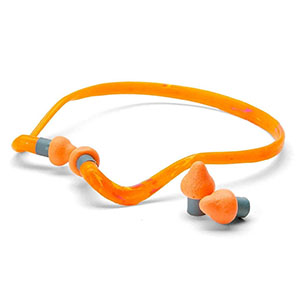
Click here for the lowest price on Amazon
You place the QB2HYG Hearing Bands in your ears like you would a stethoscope. But instead of enabling you to hear like the ‘scope does, they save your hearing from the scourge of excessive environmental noise.
What we like: They’re very light and slip into the ear without effort. We like that. We also appreciate the extra care the company took to make sure the buds don’t contact a potentially contaminated surface. And 25 NRR is sufficient for most workplaces.
Flaws: There’s no stuffing these into your pocket out of sight light simple foam plugs. And they’ll cost more than simpler ear plugs.
10. Vibes High Fidelity Earplugs
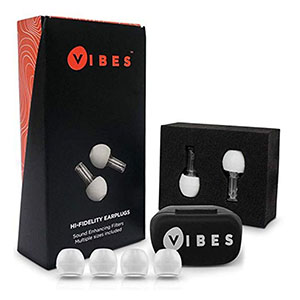
Click here for the lowest price on Amazon
Last, but by no means least, we have these stylish but uber-effective High Fidelity Earplugs from Vibes. If you’re concerned about appearances (say you work in an office), but you need to reduce the aural assault, these are perfect.
What we like: We appreciate that they provide 3 different sizes. The nifty carrying case is also a nice touch. They’re very discreet, and a lot of people will love that. The small size is also great for kids.
Flaws: It’s a good thing they’re reusable because you don’t get any extras. The unit price is also among the highest of all ear plugs.
Who Needs Ear Plugs?
These days there’s simply no way to escape the non-stop cacophony of sound. Unless, of course, you have a good set of ear plugs handy. So the answer to the question is pretty easy and straightforward: just about everybody. Beginning with construction and factory workers and including people who live in the city, people who go to clubs and concerts and the people who work in those clubs and concert venues. People who need help getting to sleep can also benefit from ear plugs. So too can those who have trouble with ear pain on airplanes and those who get seasick.
How We Ranked
There are many different brands of ear plugs on the market today. But no matter the look or the cost or the marketing, they all fulfill one primary goal: to protect your ears from loud noises. As such, we chose several dozen of the most popular ear plugs and put them to the test to see how they stacked up.
Needless to say, if they didn’t fulfill this fundamental purpose, then they didn’t make our list. Period. The ones that did were then judged on a range of other criteria. First on the list after effectiveness was comfort. If the plugs were comfortable, we considered fit. As in, did they stay in place regardless of what the tester was doing?
When it came to reusable ear plugs it was also essential to determine if they retained their malleability after repeated washes and wears. Some got stiff and became more or less useless pretty quickly. They, obviously, did not make our list. It was also important to determine if the reusable plugs were easy to clean.
Finally, we considered price. If there were two kinds of disposable ear plugs that performed equally well, but one was less expensive than the other, we went with the lower-priced option. Because, value. Also, we held the higher-priced ear plugs to a higher standard. Because that’s only right. They needed to deliver time after time with no reduction in effectiveness. If they did, they made our list.
FAQs
Q: What are ear plugs?
A: Ear plugs are a type of device that the user inserts into their ear canal to block sound. They are typically made from foam or plastic. Ear plugs also block dust, cold air, and airborne contaminants from entering the ear. But their primary function is sound mitigation.
Any time noise levels exceed 80 – 85 decibels, the possibility exists to do both short and long term damage to your ears. Ear plugs can block most damaging noise from entering your ear while still allowing you to hear enough to function safely in a work environment. Historically, ear plugs have been disposable (and many still are). But an increasing number of manufacturers are now producing reusable ear plugs.
Q: What is a ‘noise reduction rating?’
A: In order to provide people with a method for determining the sound reduction qualities of a particular set of ear plugs, the EPA devised what’s known as the Noise Reduction Rating (NRR) system. They put the earplugs through a series of scientific tests and assign an NRR rating to them based on the results. The NRR rating system starts at 0 and goes as high as 33. The higher the number, the greater the noise reduction.
Q: Does the NRR rating number equal the decibel reduction?
A: No, it doesn’t. Although this is a common misconception. People think that if they’re exposed to 100 decibels and wear ear plugs with an NRR rating of 33, the sound they’ll hear will be 67 decibels (100 – 33 = 67). In reality, it’s not so simple. You actually need to take the 33 rating, subtract 7 and then divide by 2. That gives you 13. You then deduct 13 from the total dB (100). The result is 87 dB, not 67. The fact that the EPA decided to do things this way is frustrating to some. But once you know the formula, it becomes easy.
Q: How loud is too loud?
A: Most every organization tasked with determining occupational hazards or protecting public health draws the line at around 85 dB (1). That’s about how much noise a leaf blower or lawnmower makes. So, when it comes to designing ear plugs, most manufacturers (not all) aim to filter out noises above 85 dB. In the US, OSHA requires hearing protection for all workers exposed to this level of noise for 8 hours or more (2).
Q: Can kids wear these ear plugs?
A: It’s vitally important to protect your children’s ears. But the truth is not all the ear plugs on the market (or on our list for that matter) will fit into the smaller ear canals of children. Some, like the Vibes High Fidelity Ear Plugs, come in several sizes, including a small size that will fit most kids down to around 7 or 8. Older children and teens may well be able to wear some of the narrower ear plugs on our list, such as the Mack’s Slim Fit Ear Plugs. But for very small children you may need custom-designed ear plugs.
Q: Can you share ear plugs with a friend?
A: It’s not unheard of for young people to share their ear plugs with their friend or friends at concerts and such. That, however, is a terrible idea. If one of the group has an ear infection, everyone will wind up getting it. Sharing ear plugs can also mean sharing ear mites (3). While ear mites are more common in pets, they can migrate from pets to humans. And if a person with ear mites shares their ear plugs, they may also wind up sharing ear mites too.
Q: Can ear plugs really protect your hearing?
A: They absolutely can. How good a job they do protecting your hearing will depend on several factors. Are you using ear plugs that provide an adequate level of noise mitigation for the circumstances? Are you wearing them during all the time you’re exposed to the dangerous noise? Did you get ear plugs that fit your ears snugly and comfortably? And are you reusing ear plugs you should be throwing away?
Q: Can you wear ear plugs while snorkeling?
A: Standard ear plugs like those on the above list should not be worn in the water. If you want to wear ear plugs while snorkeling or swimming to fend off ‘swimmer’s ear’ (4) you’ll need to purchase ear plugs designed specifically for that purpose. There are several different kinds on the market. Or you can go to an audiologist and have some custom-designed for you.
Q: How much do ear plugs cost?
A: Some ear plugs cost only pennies apiece. Others are going to set you back several dollars apiece. We have both types on our list. What we don’t have on our list are custom made ear plugs. These can cost as much as $300 – $400. Whether they’re actually worth that kind of money is something only you can decide.
Q: Will all ear plugs block out snoring?
A: One of the most common complaints you hear from people about ear plugs is that they can still hear their bedmate snoring. There are a couple of potential reasons for that. First of all, some ear plugs only reduce sound above 85 decibels. And rare is the person whose snoring will reach 90 or 100 decibels. Second, some cheap earplugs simply aren’t very good. The solution is to buy high-quality ear plugs that will reduce the entire sonic spectrum.
Q: Can earplugs cause an ear infection.
A: Ear plugs themselves will not cause ear infections. What can cause an ear infection, however, is putting a contaminated ear plug deep into the ear. Or placing an ear plug into a dirty ear and leaving it there all day. In each case, it’s not the ear plug itself causing the infection. It is poor handling or storage of the ear plug, or poor hygiene. If both ear plugs and ears are kept clean, there should not be any problem.
Q: Is earwax a problem for ear plugs?
A: Earwax is one of those things that only seems to get mentioned in gross comedy sketches. But it’s actually an important component of healthy ears (5). Under normal conditions earwax makes its way toward the opening of the ear canal and will fall out on its own when it’s ready. If you wear ear plugs only occasionally, they shouldn’t interfere with this process. But if you wear ear plugs all day every day, you may need to have your ears cleaned now and then to prevent excess earwax from accumulating in the ear and impeding your hearing.
Q: Do I have to clean reusable ear plugs every day?
A: Reusable ear plugs should, ideally, be cleaned after every use. That will help them maintain their effectiveness and help you avoid an ear infection. You may get away with not cleaning your ear plugs from time to time. But by doing so you’re really playing with fire because ear infections (6) are a real threat and they’re no joke. In addition, earwax build up on your ear plugs can cause them to lose their flexibility and become ineffective.
Q: Is the NRR rating always accurate?
A: We already looked at the EPA’s somewhat confusing NRR rating system. But now that we know how to interpret that rating, we need to know if the resulting number is accurate and dependable. The short answer is ‘sometimes’. The exact reasons for occasional errors have to do with the science of sound (7) and are too complex to layout here. A good rule of thumb is to overcompensate a bit, just to be sure you’re getting the protection you need.
Q: Are custom ear plugs a better idea?
A: Certainly if you need robust protection and you can afford to spend $300 or so on custom ear plugs you should not hesitate to do so. Custom ear plugs are tailored to fit comfortably into every nook and cranny of your ears. You won’t have to worry about them falling out, and you can be reasonably sure they’re blocking all the noise you want and need them to block. That said, there are plenty of commercially available ear plugs that will do a fine job.
Q: How do I clean ear plugs?
A: Before we describe how to clean your earplugs remember: cleaning disposable ear plugs won’t make them wearable again. Only wash ear plugs specifically designed to be cleaned and reused. That said, all you typically need is a bowl of warm water and some mild dishwashing detergent. Drop the ear plugs in the water and let them soak for 5 – 10 minutes.
Once the soaking has loosened up the dirt and earwax use an old toothbrush to scrub the ear plugs gently. With ‘gently’ being the keyword here. After scrubbing away the dirt, run them under some cold water. Then lay them on a clean paper towel and let them air dry. That’s it. Keep in mind that your reusable ear plugs probably came with cleaning instructions. So if those instructions conflict with what you read here, always default to the manufacturer’s recommendations.
Related Articles
Recap
The world is a noisier place than it’s ever been. Human ears simply were not designed to deal with the often extreme decibel levels we encounter as a matter of course these days. Ear plugs can help prevent short term damage to your ears and fend off long term hearing loss.
When you consider how affordable ear plugs are, you begin to understand that they are one of the best values in all of healthcare. And when that incredible value is combined with their ease of use and portability, there’s simply no good reason not to always have a pair at the ready.
Any of the ear plugs on our list will help protect your ears from the daily assault of the modern world. Use the above information to make an informed choice about which ones are right for you.
For cpoe.org’s #1 recommended ear plugs, click here.

